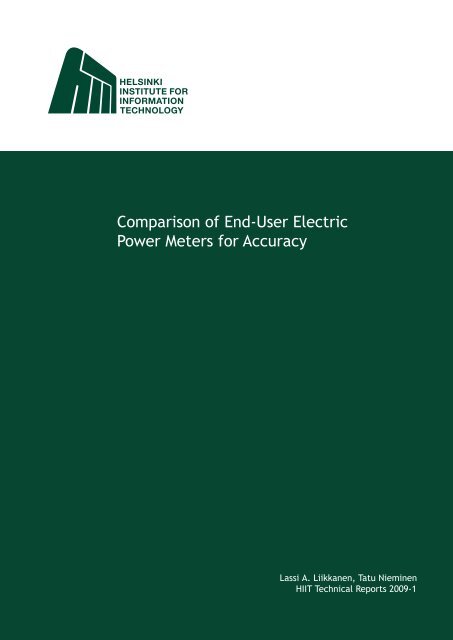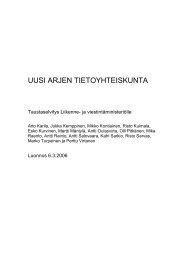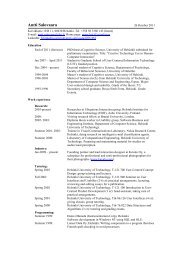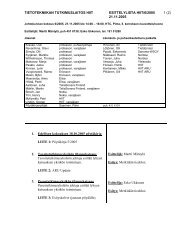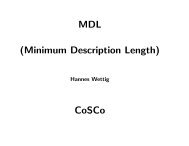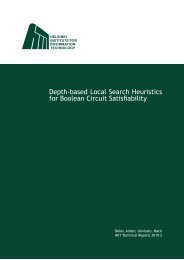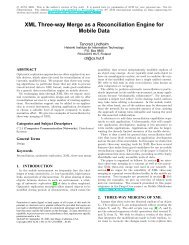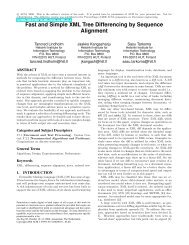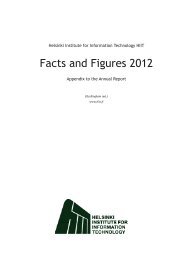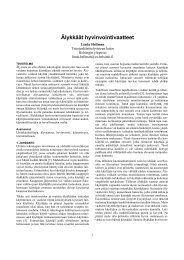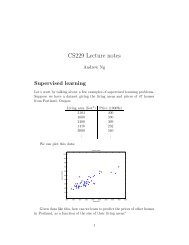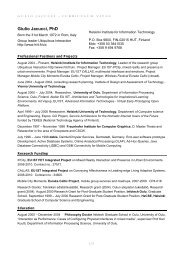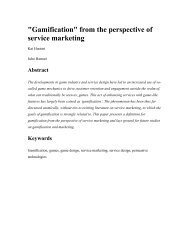Comparison of EndâUser Electric Power Meters for Accuracy
Comparison of EndâUser Electric Power Meters for Accuracy
Comparison of EndâUser Electric Power Meters for Accuracy
You also want an ePaper? Increase the reach of your titles
YUMPU automatically turns print PDFs into web optimized ePapers that Google loves.
<strong>Comparison</strong> <strong>of</strong> End‐User <strong>Electric</strong><br />
<strong>Power</strong> <strong>Meters</strong> <strong>for</strong> <strong>Accuracy</strong><br />
Lassi A. Liikkanen, Tatu Nieminen<br />
HIIT Technical Reports 2009-1
Lassi A. Liikkanen<br />
Helsinki Institute <strong>for</strong> In<strong>for</strong>mation Technology HIIT<br />
Helsinki University <strong>of</strong> Technology TKK<br />
PO Box 9800, 02015 TKK, Finland<br />
Lassi.Liikkanen@hiit.fi<br />
Tatu Nieminen<br />
Department <strong>of</strong> <strong>Electric</strong>al Engineering<br />
Helsinki University <strong>of</strong> Technology TKK<br />
PO Box 3000, 02015 TKK, Finland<br />
Tatu.Nieminen@tkk.fi<br />
Version 1.1, revised 21 st July 2009.<br />
Technoline availabity and Plogg price corrected.<br />
Helsinki Institute <strong>for</strong> In<strong>for</strong>mation Technology HIIT<br />
HIIT Technical Reports 2009–1<br />
ISBN 978‐951‐22‐9489‐3 (electronic)<br />
ISSN 1458‐9478 (electronic)<br />
Copyright © 2009 Lassi A. Liikkanen, Tatu Nieminen<br />
All photographs by Lassi A. Liikkanen
<strong>Comparison</strong> <strong>of</strong> End‐User <strong>Electric</strong><br />
<strong>Power</strong> <strong>Meters</strong> <strong>for</strong> <strong>Accuracy</strong><br />
Liikkanen, Lassi A. 1 and Nieminen, Tatu 2<br />
1<br />
Helsinki Institute <strong>for</strong> In<strong>for</strong>mation Technology HIIT,<br />
Helsinki University <strong>of</strong> Technology TKK<br />
PO Box 9800, 02015 TKK, Finland<br />
2<br />
Department <strong>of</strong> <strong>Electric</strong>al Engineering,<br />
Helsinki University <strong>of</strong> Technology TKK<br />
PO Box 3000, 02015 TKK, Finland<br />
E‐mails: 1 <strong>for</strong>ename.surname@hiit.fi, 2 <strong>for</strong>ename.surname@tkk.fi<br />
Abstract. In the present study, we investigated the technical qualities <strong>of</strong> power<br />
consumption meters. A selection <strong>of</strong> nine meters available at general electric and<br />
discounts stores was selected <strong>for</strong> an evaluation along with two more expensive<br />
products and one prototype meter. The majority <strong>of</strong> the af<strong>for</strong>dable devices fell into<br />
the price range <strong>of</strong> 10‐20 Euros. In the test, variable load combinations were used to<br />
asses the meters in reference to a known, calibrated power quality measurement<br />
device. The loads included small and reactive loads estimated to be difficult <strong>for</strong> the<br />
meters. The accuracy <strong>of</strong> the measured devices was very variable, some meters<br />
qualifying with small resistive loads, the majority <strong>of</strong> meters with high resistive<br />
loads. The found inaccuracies were predominantly negative. The devices<br />
underestimated the consumption and some devices had more than 25% error. In this<br />
report we document these measurements and reveal the relative qualities <strong>of</strong> the<br />
tested products, highlighting two products.<br />
Keywords: power consumption meters, electrict power meter, accuracy, usability<br />
1. Introduction<br />
In 2009 the European Commission has just recently released a new climate and<br />
energy package (European Parliament, 2008). This act has been discussed in length<br />
in several media, along with other anti‐climate change maneuvers. Together these<br />
timely debates draw the attention <strong>of</strong> European citizens into energy issues. When<br />
ecological awareness comes coupled with the increasing trend in electricity prices<br />
in Northern‐Europe, an incentive may arise <strong>for</strong> consumers to think more carefully<br />
about their electricity consumption. Recent study shows economical incentives are<br />
the primary reason why people take action (see, Liikkanen, 2009). One <strong>of</strong> these<br />
actions is to seek out in<strong>for</strong>mation about how much electricity is consumed by<br />
different household appliances. This can be achieved using electric power meters.<br />
People may be interested to find out do they possess a defective device, or be<br />
1
interested just to learn about the energy consumption <strong>of</strong> their electrical devices.<br />
These needs can be satisfied using end‐use electric power meters which have<br />
become af<strong>for</strong>dable and widely available in Northern‐Europe, Finland by end <strong>of</strong> the<br />
year 2008. However, the availability <strong>of</strong> inexpensive meters does not yet guarantee<br />
a benefit <strong>for</strong> the consumer if the cheap price is a consequence <strong>of</strong> poor design and<br />
mediocre technical quality.<br />
There are several reasons to suspect that the technical quality may be<br />
compromised. Our first concern is the dynamic range requirement to correctly<br />
measure and represent all loads <strong>of</strong> interest. The second issue is the behavior <strong>of</strong> the<br />
inexpensive meters when loaded with non‐linear, non‐resistive loads. Particularly<br />
the reactive power component (Harrison, 1996) is suspected to impair the accuracy<br />
<strong>of</strong> the measurements conducted with af<strong>for</strong>dable measurement devices. Reactive<br />
power represents the power component that is out‐<strong>of</strong>‐phase from the mains<br />
voltage. With the increasing number <strong>of</strong> fluorescent lamps, including so called<br />
energy‐saving bulbs (compact fluorescent lamps, or CFLs), the number <strong>of</strong> reactive<br />
load inducing measurement targets in households has increased.<br />
Small loads are technically more challenging than big loads, because we assume<br />
that the power meters are normally designed <strong>for</strong> a typical maximum fuse load <strong>of</strong><br />
16 amperes. To per<strong>for</strong>m adequately also with small loads, the devices should have<br />
a considerable measurement range. Even though the contribution <strong>of</strong> small loads to<br />
the total energy consumption may negligible, there also several reasons to take<br />
small loads seriously. The increasing number <strong>of</strong> electric devices with standby<br />
states can create a considerable waste <strong>of</strong> electricity globally. Because <strong>of</strong> this, the<br />
Commission <strong>of</strong> the European Communities is endorsing the 1‐watt initiative as<br />
one part <strong>of</strong> recent ecodesign requirements <strong>for</strong> new electronic devices (EBPG, 2007).<br />
We interpret this specification so that a properly functioning power meter should<br />
be able to handle loads from 1W, or 1/230 A, up to the maximum typical fuse load<br />
<strong>of</strong> 16A. This corresponds to a dynamic range <strong>of</strong> 1:3680, which in practice calls <strong>for</strong><br />
16‐bit resolution from digital circuits.<br />
For the interests <strong>of</strong> benchmarking and evaluating the options available <strong>for</strong> Finnish<br />
consumer, we decided to test a variety <strong>of</strong> power meters. In this paper we report<br />
our ef<strong>for</strong>ts in testing how a selection <strong>of</strong> these devices per<strong>for</strong>ms in different<br />
measurement conditions. For the test, we have chosen loads that resemble typical<br />
devices found in Finnish households, including the a<strong>for</strong>ementioned loads that are<br />
potentially challenging <strong>for</strong> the meters. After presenting the power meter range,<br />
test methodology and results, we conclude that some af<strong>for</strong>dable devices provide<br />
value <strong>for</strong> the money, but the quality is very variable. Surprisingly, even a 10 euro<br />
device can accurately measure both small loads and devices with low power<br />
factor, high reactive power component.<br />
2
2. Tested Devices<br />
Eight af<strong>for</strong>dable devices easily available <strong>for</strong> consumers in Finland, Greater‐<br />
Helsinki region, were acquired <strong>for</strong> the test. The units were bought anonymously<br />
from retail shops to avoid any bias. In addition, one inexpensive meter<br />
(Technoline) was obtained from a co‐operating utility where it had been circulated<br />
among their customers. It can be purchased, <strong>for</strong> instance, from Amazon.de or in<br />
Finland from Paratronic Oy. We include also two more expensive devices to<br />
evaluate if there are noticeable differences between price categories, although<br />
these meters (Plogg and Christ‐Elektronik) are not commonly available or <strong>of</strong><br />
interest to consumers. An experimental research sensor prototype was also<br />
included <strong>for</strong> benchmarking purposes. All measured devices were new, except<br />
Technoline and Christ‐Elektronik. The selection <strong>of</strong> power consumption meters<br />
involved in this study is found in Table 1 below:<br />
Table 1. The technical specifications <strong>of</strong> the tested devices. Columns from left to right<br />
sorted by ascending price.<br />
Basic in<strong>for</strong>mation<br />
Dealer<br />
LIDL<br />
Clas<br />
Ohlson<br />
Technoline<br />
Hong<br />
Kong<br />
Verkkokauppa<br />
Clas<br />
Ohlson Motonet Velleman Onninen Plogg<br />
Christ<br />
Elektronik<br />
EMT707C Cost<br />
NETBSE REV TS-<br />
Model<br />
PM333 TL control FHT-9999 FHT-9999 PM300 PM300 M2 JD Blu v2.0 CLM200<br />
Retail price in €* 13 14 14 13 20 20 20 20 40 ~110 ~180<br />
Ratings<br />
Max. current [A] 10 16 16 16 16 16 16 16 10 16 16<br />
Minimum [VA] 1.15 5 - 5 5 0.46 0.46 4.6 0 - 5<br />
Features<br />
Voltage - X - - - X X X X X -<br />
Current X X - - - X X X X X -<br />
Maximum current X - - - - X X X - ? -<br />
kWh consumption X X X X X X X X X X X<br />
Tariff settings 1 1 1 2 2 1 1 2 1 2 -<br />
Timer / clock - - - X X X X X X ? -<br />
Overload warning X - - - - X X - - - -<br />
<strong>Power</strong> factor X X - - - - - X - - -<br />
Frequency in Hz X X - - - - - X - X -<br />
<strong>Power</strong> supply <strong>for</strong><br />
the meter<br />
2 x LR44<br />
Battery<br />
Internal<br />
battery<br />
1 x LR44<br />
Battery<br />
Internal<br />
battery<br />
Internal<br />
battery<br />
2x LR44<br />
battery<br />
2x LR44<br />
battery<br />
3x LR44<br />
Internal<br />
battery - -<br />
RMS,<br />
reactive, External<br />
angle display<br />
Other features<br />
X = feature available - = feature not present<br />
Tested features<br />
Startup dealy 0 0 0 >15s. >15s. 0 0 0 0 ** 0<br />
Off-line<br />
functionality*** X - X - - X X X - - -<br />
Display viewing<br />
angle Narrow Narrow Wide Medium Medium Wide Wide Medium Narrow - Wide<br />
* = price in Euro as <strong>of</strong> early 2009, rounded up to the closest euro ** = not measured (Bluetooth connection)<br />
*** = indicates whether the device can be operated without mains current<br />
By looking at the product and their specifications, it becomes obvious that there<br />
are fewer producers than brand names. Identical products are being sold under<br />
different labels. This shows in our selection <strong>of</strong> devices which includes two<br />
appliances with a model name FHT‐9999 and two with the name PM300. This is<br />
3
quite typical <strong>of</strong> brand discount stores. It is probable that other identical products<br />
with different or identical model names exist in the market. Photographs <strong>of</strong> the<br />
devices are presented in the Summaries section and may help to identify clones.<br />
3. Method<br />
3.1. Test environment<br />
Tests were carried out in the power quality laboratory in Department <strong>of</strong> <strong>Electric</strong>al<br />
Engineering <strong>of</strong> the Helsinki University <strong>of</strong> Technology TKK (Espoo, Finland). The<br />
laboratory’s electricity is routed through a filter <strong>for</strong> high frequency noise and the<br />
laboratory is also shielded from electric fields.<br />
During the tests, power was supplied by Schaffner Pr<strong>of</strong>line 2100 EMC test system.<br />
This generator can produce up to 5 kVA per phase and voltage between 0‐300 V<br />
with frequencies <strong>of</strong> 16‐500 Hz. During tests voltage was set to 230 V (50 Hz),<br />
corresponding to the nominal network voltage. This power supply ensured that<br />
different test sets utilized constant input voltage, independent <strong>of</strong> network voltage<br />
and free from other power instability issues.<br />
To evaluate the per<strong>for</strong>mance <strong>of</strong> the meters, a reference device was utilized.<br />
Reference measurements were taken with TOPAS 1000 power quality analyzer.<br />
TOPAS 1000 is an 8 channel computer‐operated power quality measurement<br />
device. It has a 16 bit precision and its channels are electrically isolated. TOPAS is<br />
meant <strong>for</strong> measuring three‐phase systems and since all channels are separate from<br />
each other, there is no galvanic connection between measurement connections.<br />
This means that all measurements are independent and can sample different<br />
voltages and currents.<br />
3.2. Loads<br />
For the measurement, electrical loads were necessary to determine the accuracy <strong>of</strong><br />
the meters. Six different types <strong>of</strong> loads covering a wide spectrum <strong>of</strong> nominal<br />
ratings (from 1 to 600 W) and behavior (in terms <strong>of</strong> power factor and capacitive or<br />
conductive load) were chosen <strong>for</strong> the test. These were divided into small ( less than<br />
20 W nominal) and regular (> 20 W ) loads. Two <strong>of</strong> the loads were small, four<br />
regular, they are listed in Table 2..<br />
Table 2. Summary <strong>of</strong> the utilized loads.<br />
# Load description<br />
1. 15W compact fluerescent lamp<br />
2. Battery eliminator 1W@5V load<br />
3. 2x36W fluerescent tubes<br />
4. CRT display + PC (Non-PFC), web browser, instantaneous power<br />
5. 200W dimmed incandescent bulbs (460 W nominal)<br />
6. 600W resistor<br />
4
The small loads we used were a charger and a compact fluorescent lamp. Battery<br />
eliminator with 1 W load is a normal small voltage trans<strong>for</strong>mer with resistive load<br />
(24 Ω) connected to it. This corresponds to a typical very small load, such as<br />
charging a mobile device. Compact fluorescent lamp (CFL) also has a low nominal<br />
power (15 W)and a very difficult current wave<strong>for</strong>m.<br />
In the category <strong>of</strong> regular loads, 2x36 W fluorescent tubes have choke to limit<br />
current flow, which makes their load bit inductive. Even more challenging target<br />
was an older, non‐power factor corrected computer (non‐PFC ATX PC, AMD 1<br />
GHz Duron). In the tests, a webpage was opened on full screen, simulating web<br />
surfing, and screensaver and power saving modes were disabled . There<strong>for</strong>e this<br />
computer did not have major difference in consumption between different<br />
computational loads. Parallel to the PC, we connected a 19” CRT monitor to test<br />
meters capability to measure switching power supply load. This older computer<br />
also had high power consumption, and the combined nominal power <strong>of</strong> the setup<br />
was 170 W. This computer setup was used to per<strong>for</strong>m the electricity consumption<br />
measurement.<br />
Incandescent lamps dimmed to operate at 200 watts (nominal 440 W) were used to<br />
test meters capability to measure clipped current. The dimmer holds current from<br />
flowing until the amplitude <strong>of</strong> voltage reaches the level set by the switch. Current<br />
flows again until the next zero crossing <strong>of</strong> current occurs. This causes current to<br />
have sudden changes and harmonics. The final load was 600 W resistor which<br />
resembles an electrical heating radiator or a hot plate. With this kind <strong>of</strong> load,<br />
current is in phase with voltage which should make it the easiest possible target to<br />
measure. This test also reveals how accurately meters can handle higher currents.<br />
3.3. Procedure<br />
During the measurement, all meters were plugged one meter after another so that<br />
they all measured the same phase (see Figure 1 <strong>for</strong> an illustration). Although the<br />
phase remains constant, this produces some error since meters do not measure<br />
their self consumption and meters’ power is taken mostly with direct capacitive<br />
coupling to phase voltage. This capacitive coupling also creates some error when<br />
measuring small inductive loads as meters’ capacitive connection cancels some <strong>of</strong><br />
the inductive current on load. Almost all meters measure current with shunt<br />
resistor which means that on higher loads the voltage drop over each meter will<br />
affect meters after it. These errors were considered negligible as the reference<br />
measurements taken from directly be<strong>for</strong>e the meter stack and after the meters, just<br />
be<strong>for</strong>e the load. Reference measurement itself did not affect measured signals.<br />
5
Figure 1. Meter stack containing 9 <strong>of</strong> the measured devices (illustration).<br />
The tests began with pilot tests which employed a subset <strong>of</strong> meters, a wider<br />
selection <strong>of</strong> loads (including the six documented here) and were used to check the<br />
procedure. The power meter from Onninen broke down by the end <strong>of</strong> the pilot<br />
test. <strong>Meters</strong> internal 10 A fuse blew in a maximum load test and changing the fuse<br />
did not fix the meter. The results regarding Onninen reported here are based on<br />
comparing Onninen’s pilot measurements to parallel PloggBlu measurements.<br />
The actual measurements were done in two sets. The first set consisted <strong>of</strong> 7 meters.<br />
It included Christ‐Elektronik CLM 200, Clas Ohlson PM300, LIDL PM333,<br />
Verkkokauppa.com FHT‐9999, Hong‐Kong FHT‐9999, Motonet PM300 and<br />
BeAware prototype. The second set included Clas Ohlson EMT707CTL,<br />
Technoline Cost Control and Velleman NETBSEM2. The first batch was tested<br />
during 4 th ‐6 th <strong>of</strong> February and the second set 1 st ‐2 nd <strong>of</strong> April 2009.<br />
TOPAS 1000 reference measurement device was connected to measure current and<br />
voltage on two separate connection points between load and supply. This was<br />
made so that measurements <strong>for</strong> different meters would be comparable since all<br />
meters in a set were connected in series. TOPAS was set to continuously measure<br />
RMS values with integration time <strong>of</strong> 10 seconds and instantaneous measurements<br />
were updated every 15 seconds. All measurements were also recorded on TOPAS’<br />
hard drive <strong>for</strong> further analysis and cumulative energy measurement.<br />
After the measurements, we calculated a unique reference value <strong>for</strong> each meter<br />
based on its relative position in the stack. The reference value was calculated by<br />
assuming a linear function between the measurement points, that is, assuming an<br />
equal voltage loss and power consumption per meter. It should be noted the<br />
power consumption <strong>of</strong> the meters was generally below one watt, expect when the<br />
rechargeable battery‐driven meters were charging.<br />
6
Cumulative energy consumption measurements were done by leaving on the<br />
computer and when enough time had passed, the PC was shut down and the<br />
energy measurements were taken from meters. Measurement time <strong>for</strong> first set was<br />
16.5 hours and 22 hours <strong>for</strong> the second set. Some <strong>of</strong> the measured loads where<br />
instable because they warmed up and their consumption changed <strong>for</strong> a short<br />
period after turning them on. Where needed measurements where taken after load<br />
current had become stable. This was required on computer and on both<br />
fluorescent lamps. If the readings were still drifting, typically between two<br />
adjacent numbers, then the highest reading appearing within a 5 second window<br />
was selected. All loads on each meter were measured once.<br />
3.4. Analysis<br />
The meter accuracy was estimated as an average measurement error <strong>of</strong> the meter.<br />
The accuracy was determined as a relative deviance from the meter‐specific<br />
reference values. We started by including the type <strong>of</strong> deviance, above or below<br />
reference, but eventually all error scores were calculated as absolute deviances.<br />
This meant that we could calculate an average error across all load conditions by<br />
simply summing up the absolute error percentages from all measurements.<br />
To help to interpret the data, we further classified the error percentages. Inspired<br />
by the idea <strong>of</strong> tolerance commonly applied in electronics, we trans<strong>for</strong>med the error<br />
ranges were into scores, or three categories <strong>of</strong> error ranges; < 5 %, < 10%, > 10 %.<br />
Devices within 5% <strong>of</strong> the reference reading received score 3 (excellent), within 10%<br />
adequate (2 points), over 10% with 1 point (poor), and when no reading could be<br />
obtained 0 points (failure) The measurements <strong>of</strong> the small and regular loads, and<br />
consumption were further aggregated as category averages.<br />
In the results section, we have additionally included some findings regarding the<br />
usability <strong>of</strong> the tested products. We consider the display viewing angles and the<br />
readability <strong>of</strong> the meter after it has been detached from the mains current.<br />
7
4. Results<br />
4.1. Summary about accuracy<br />
Each meter was tested against the six loads as described in 3. The error ranges<br />
were derived from the relative deviations <strong>of</strong> the meter reading and the reading <strong>of</strong><br />
the reference device. The average errors in absolute figures were also calculated<br />
<strong>for</strong> all devices, and their average was 9.2% (standard deviation = 6.3%). The<br />
average errors associated with individual devices are displayed in Figure 2 below:<br />
Verkkokauppa.com FHT-9999<br />
Hong-Kong FHT-9999<br />
19 %<br />
18 %<br />
Clas Ohlson PM300<br />
15 %<br />
Motonet PM300<br />
LIDL PM333<br />
12 %<br />
12 %<br />
Velleman NETBSEM2<br />
BeAw are prototype<br />
Christ-Elektronik CLM200<br />
6 %<br />
6 %<br />
6 %<br />
Clas Ohlson EMT707CTL<br />
Technoline Cost control<br />
Plogg Blu v2.0<br />
2 %<br />
3 %<br />
3 %<br />
Average error<br />
0 % 5 % 10 % 15 % 20 % 25 %<br />
Figure 2. The average errors in each meter in comparison to the reference value.<br />
All errors are presented as absolute values deviating from the reference.<br />
We found no relation between the accuracy <strong>of</strong> the device and its retail price (see<br />
Figure 3). This was not surprising in the given price range, because the<br />
manufacturing costs <strong>for</strong> the tested devices are likely very similar. Bit surprising<br />
was that the two more expensive devices did not per<strong>for</strong>m significantly better.<br />
Weighted tolerance score<br />
3.00<br />
2.50<br />
2.00<br />
1.50<br />
1.00<br />
0.50<br />
Price versus accuracy<br />
Price in Euro<br />
0.00<br />
0 20 40<br />
Figure 3. Relation <strong>of</strong> price and accuracy. The two most expensive meters excluded.<br />
8
The error range scores are presented as absolute figures, so that the directions <strong>of</strong><br />
the deviances are not considered. However, the analysis <strong>of</strong> errors revealed that in<br />
the 73.3% <strong>of</strong> measurements the deviances were negative, i.e. the device<br />
underestimated the amount <strong>of</strong> electric power. If only 10% deviances are<br />
considered, this balance remains, 75.0% <strong>of</strong> devices still underestimate the load.<br />
This trend is illustrated in Figure 4.<br />
Number <strong>of</strong> errors in the category<br />
20<br />
18<br />
16<br />
14<br />
12<br />
10<br />
8<br />
6<br />
4<br />
2<br />
0<br />
63 %<br />
67 %<br />
71 %<br />
75 %<br />
79 %<br />
83 %<br />
87 %<br />
91 %<br />
95 %<br />
99 %<br />
103 %<br />
107 %<br />
111 %<br />
115 %<br />
119 %<br />
123 %<br />
127 %<br />
Figure 4. The distribution <strong>of</strong> errors across all measured devices and all<br />
measurements. The measurements have been categorized into 2% categories (Xaxis)<br />
and the number <strong>of</strong> deviations in each category is indicated on the Y‐axis.<br />
100% represents the correct measurement in comparison to the reference values,<br />
categories below 100% are marked in gray, over 100% in black.<br />
Of all tested meters, PloggBlu was clearly the most accurate device with less than<br />
2% average error. The score <strong>of</strong> expensive Christ‐Elektronik was reduced by poor<br />
per<strong>for</strong>mance with the smallest load. The accuracy scores <strong>of</strong> Technoline Cost<br />
control and Clas Ohlson EMT707CL are very impressive considering their price.<br />
The details about the accuracy <strong>of</strong> each device are given on the next page in Table 3.<br />
For the table, we have provided the scores <strong>for</strong> each load and categorized them into<br />
consumption, small instantaneous loads, and regular instantaneous loads. Each<br />
category has its own category average figure. On the bottom <strong>of</strong> table, the scores in<br />
each category are summed to a weighted average. The consumption has a<br />
relatively big weight, 40% as accurate readings over a long period time are<br />
considered viable <strong>for</strong> many purposes. Both classes <strong>of</strong> instantaneous power have<br />
the same weighting. This may exaggerate the differences in measuring small loads,<br />
which seemingly contribute little to the overall consumption, but are nevertheless<br />
important <strong>for</strong> stand‐by measurements. The reader is urged to re‐calculate the<br />
figures according to the desired weighting scheme.<br />
9
Table 3. Summary <strong>of</strong> the measurements. Scores stand <strong>for</strong> error ranges<br />
(3 points = 20 W load<br />
4. 70W fluerescent tub. 3 3 3 3 3 3 3 3 3 3 3<br />
5. 170W PC, Non-PFC 1 3 3 3 3 1 1 3 3 3 3<br />
6. 200W dimmed bulbs 1 2 3 2 3 1 3 3 2 2 3<br />
7. 600W resistor 3 3 3 3 3 3 3 3 3 3 3<br />
Category average 2 2.75 3 2.75 3 2 2.5 3 2.75 2.75 3<br />
Weighted scores<br />
Consumption<br />
40.0 % 0.40 1.20 1.20 1.20 1.20 0.40 0.40 1.20 1.20 1.20 1.20<br />
Instant. power, < 20 W<br />
30.0 % 0.90 0.75 0.75 0.15 0.15 0.30 0.30 0.30 0.90 0.60 0.60<br />
Instant. power, > 20 W<br />
30.0 % 0.60 0.83 0.90 0.83 0.90 0.60 0.75 0.90 0.83 0.83 0.90<br />
Total score 1.90 2.78 2.85 2.18 2.25 1.30 1.45 2.40 2.93 2.63 2.70<br />
Measurement data and <strong>for</strong> different measurements <strong>of</strong> individual devices are<br />
available by request from the authors.<br />
4.2. Usability<br />
In this evaluation we did not conduct any full‐scale usability evaluation. This was<br />
because the primary interest was in determining the technical quality <strong>of</strong> the<br />
appliances and because the functions provided by the devices differ considerably.<br />
However, some observations were made. The fact that the majority <strong>of</strong> devices<br />
contain a similar number <strong>of</strong> control buttons implies that the devices with a greater<br />
number <strong>of</strong> functions may be more difficult to operate. While our observations<br />
during the tests confirmed this, we did not encounter any major usability issues<br />
with the interfaces. All meters provided a straight<strong>for</strong>ward access to the most<br />
important consumption and power figures in a straight‐<strong>for</strong>ward manner.<br />
However, two concerns came up in the inspection.<br />
The LCD display viewing angles were an issue, because sometimes the meters<br />
very difficult to read. Even though we operated the devices in a quite flexible and<br />
open laboratory setting, we had repeated difficulties in reading some <strong>of</strong> the<br />
devices. These observations are presented in the lowermost part “Tested features”<br />
<strong>of</strong> Table 1. The devices with viewing angles evaluated as “narrow” were only<br />
readable when viewed directly. “Medium” score indicates a wider, but still<br />
10
constrained viewing angle and “wide” displays are the only ones that can be read<br />
from various angles.<br />
Viewing angles are an important property because all inexpensive devices have<br />
the display fixed the body <strong>of</strong> the meter. As the user has no other way to extract the<br />
electricity consumption data this means that the readability <strong>of</strong> the display<br />
determines the usefulness <strong>of</strong> the device. While battery‐powered devices (5 <strong>of</strong> all<br />
tested) can provide consumption figures without power input, reading<br />
instantaneous power always requires the device to be plugged in. In many homes,<br />
electric plugs <strong>for</strong> many basic appliances, such as fridge, dish washer, freezer etc.,<br />
can be in difficult to access locations. If the meter is not readable from a wide<br />
range it maybe impossible to use in these environments. This applies to all<br />
af<strong>for</strong>dable units that are more or less <strong>of</strong> the same volume. The display issue can be<br />
circumvented if the display is an external device, as in Christ‐Elektronik CLM‐200,<br />
or if the data can be transferred wirelessly from the meter to a receiver device.<br />
PloggBlu v2 utilizes the latter option by allowing the user to receive the<br />
consumption in<strong>for</strong>mation via Bluetooth connection. The maximum current<br />
function available in some <strong>of</strong> meters (see Table 1) may also circumvent this<br />
problem partially.<br />
We also noted that some <strong>of</strong> the battery‐powered devices may take a considerable<br />
amount <strong>of</strong> time to power on. This is a consequence <strong>of</strong> their structure; these meters<br />
charge their battery from the mains when connected. If they are stored normally,<br />
then they will loose the charge and will have to re‐charge themselves be<strong>for</strong>e they<br />
can be operated. This may render the device useless if the battery dies completely.<br />
11
5. Conclusion and Summaries<br />
In summary, the range <strong>of</strong> power consumption meters available <strong>for</strong> end users is<br />
wide. By selecting the right device, a consumer can acquire an accurate meter<br />
af<strong>for</strong>dably. However, with inexpensive devices, there are usually drawbacks. In<br />
the tested devices, the biggest problem was usually the embedded display,<br />
which may seriously hinder their usage across physical locations <strong>of</strong> a<br />
household. In future, we expect to see very different, much more flexible<br />
solutions <strong>for</strong> addressing the needs <strong>of</strong> measuring electricity consumption at<br />
home.<br />
In this paper we have reported an evaluation <strong>of</strong> nine consumer electric power<br />
meters. This work was motivated by the recent introduction <strong>of</strong> this product<br />
typology to the consumer market. This indicates that there is demand <strong>for</strong> this kind<br />
<strong>of</strong> energy in<strong>for</strong>mation (Liikkanen, 2009). <strong>Power</strong> consumption meters are a quite<br />
simple way <strong>of</strong> trying to empower consumers. The present availability <strong>of</strong> cheap<br />
devices and borrowing services makes it easy <strong>for</strong> consumers to adapt an active<br />
role in their electricity consumption. However, do the present meters provide<br />
adequately accurate data in order to lead to right direction?<br />
In the present study we investigated the accuracy <strong>of</strong> nine af<strong>for</strong>dable power meters<br />
using three different types <strong>of</strong> measures in a laboratory. We inspected the meters<br />
<strong>for</strong> instantaneous power reading with both small and regular loads. The loads<br />
were chosen to be representative <strong>of</strong> types <strong>of</strong> devices users might commonly own<br />
and be interested to measure. Additionally we investigated the accuracy <strong>of</strong><br />
consumption measurement by letting the meters run continuously over 16 hours<br />
while a desktop computer was idling. Generally, the devices per<strong>for</strong>med best in<br />
measuring large, instantaneous loads and had the most difficulties with small<br />
loads. We had expected the small loads to be problematic because many <strong>of</strong> the<br />
tested devices were not even specified to handle small loads properly (see Table 1<br />
<strong>for</strong> minimum VA). This partially explains the present results. The response to the<br />
reactive power was surprisingly good and only three devices had notable<br />
problems in calculating the effective power out <strong>of</strong> the total consumption.<br />
The accuracy readings we have presented do not reveal the total technical quality<br />
<strong>of</strong> the devices. We did not make tests <strong>of</strong> re‐test reliability, prolonged endurance, or<br />
power quality tolerance. However, the fact that we witnessed the break down <strong>of</strong><br />
one <strong>of</strong> the devices (Onninen REV TS‐JD) during our normal test procedure, implies<br />
that the manufacturing quality <strong>of</strong> the appliances may match their price tag. About<br />
the more expensive devices, such as Christ‐Elektronik CLM 200, we know that the<br />
utility which borrowed us the device has been circulating the meter <strong>for</strong> several<br />
years among its customers. The specific device we tested has likely been used by<br />
12
tens if not hundreds <strong>of</strong> customers be<strong>for</strong>e the test, implying a strong record <strong>for</strong><br />
robustness. Even though we measured only a single device from each brand, some<br />
hints <strong>of</strong> this manufacturing tolerance can be seen in the slightly different accuracy<br />
ratings <strong>for</strong> devices that look identical and probably also host the same electronic<br />
design (although this was not ascertained).<br />
Our present results show that the technical quality <strong>of</strong> inexpensive power meters is<br />
variable. If a consumer makes an unin<strong>for</strong>med guess in buying a meter, the<br />
acquired meter may provide readings with an average error <strong>of</strong> almost 20% and<br />
even in critical use cases, such as measuring long‐term consumption. Of course,<br />
even this poor resolution maybe adequate <strong>for</strong> some purposes, but generally it<br />
unconceivable that someone would like to pay <strong>for</strong> 20% extra on their electricity bill<br />
by mistake. However, with the help <strong>of</strong> the present results, a consumer can find an<br />
af<strong>for</strong>dable device that provides surprisingly accurate data. Two <strong>of</strong> the tested<br />
meters with a street price less than 15 euro per<strong>for</strong>med with less than 5% error<br />
under various conditions. On the other hand, a step away from the inexpensive<br />
consumer products category to 50‐250 euro adds only little to meters’ accuracy but<br />
does increase their usefulness and flexibility.<br />
Beyond the accuracy, the tested products have a few potential usability issues. The<br />
biggest concern <strong>for</strong> their practicality comes from their built‐in displays. Some<br />
models include LCD displays that are readable only from a very constrained<br />
angle. This severely limits their usefulness in places where the space is scarce;<br />
close to the floor, ceiling, walls, or where ever power outlets are commonly located<br />
in. Although extensions cords may help to circumvent this problem, the viewing<br />
angles are a major problem. In the more expensive Plogg and Christ‐Elektronik<br />
this is not an issue by because the display unit is not fixed to the body <strong>of</strong> meter.<br />
Another issue encountered in two <strong>of</strong> the meters was the internal battery. The disand<br />
re‐charging <strong>of</strong> the battery slows down the operation, which is annoying <strong>for</strong><br />
the operation and maybe fatal in a longer term.<br />
Looking to the future <strong>of</strong> power meters, it is hardly necessary to make the meters<br />
any more accurate (on average). However, the data extraction and interpretation<br />
will need more attention. Future smart home systems, such as those envisioned by<br />
the BeAware project (see acknowledgements), should produce the power<br />
measurements in a new kind <strong>of</strong> way that simplifies the measurements and<br />
facilitates making the right inferences from the readings (Liikkanen, 2009).<br />
Usability will be a major concern as new features, such as social networking and<br />
mobile access become introduced.<br />
13
5.1. Individual devices<br />
Lidl PM333<br />
13 € <strong>Accuracy</strong>: 1.9 / 3<br />
Clas Ohlson EMT707C TL<br />
14 € <strong>Accuracy</strong>: 2.8 / 3<br />
Average error: 12.2 %<br />
The cheapest unit included in the test per<strong>for</strong>med<br />
well with small loads. Despite the fact that it can<br />
display power factor, it did not do well with reactive<br />
loads. Consumption and bigger load measurements<br />
were also inaccurate. The device has lots <strong>of</strong><br />
functions but its usage is severely restricted by the<br />
reduced viewing angles <strong>of</strong> the display.<br />
Average error: 3.2 %<br />
The new model branded by Clas Ohlson<br />
manufactured by EverFlourish was a very positive<br />
surprise. It per<strong>for</strong>med very well across conditions,<br />
handling all loads properly. It has a good selection<br />
<strong>of</strong> features, but suffers considerably from the poorly<br />
readable display.<br />
Technoline Cost control<br />
Best value <strong>for</strong> the money<br />
Appr. 14 € <strong>Accuracy</strong>: 2.9 / 3<br />
Hong Kong FHT‐9999<br />
13 € <strong>Accuracy</strong>: 2.2 / 3<br />
<br />
Average error: 2.6 %<br />
Technoline had the second best accuracy <strong>of</strong> all<br />
devices we tested. Given the price, this is was quite<br />
surprising. The device also embeds an excellent<br />
display. On the downside, this device has only the<br />
basic functions, instantaneous power, consumption,<br />
and cost. However, these will likely suffice <strong>for</strong> most<br />
customers. Cost control is currently not available in<br />
Finland.<br />
Average error: 17.8 %<br />
This meter is equipped with an internal battery<br />
which allows it to be operated even when<br />
disconnected from the mains. However, the capacity<br />
<strong>of</strong> the battery seems pretty poor as we witnessed<br />
long startup delays when the device was reconnected.<br />
The device has the basic functions and<br />
provides average accuracy. Even though the reactive<br />
loads are handled quite well, small loads are not.<br />
This per<strong>for</strong>mance can not be justified by the price, so<br />
the verdict is unsatisfactory.<br />
14
Verkkokauppa.com FHT‐9999<br />
20 € <strong>Accuracy</strong>: 2.3 / 3<br />
Velleman NETBSE M2<br />
20 € <strong>Accuracy</strong>: 2.4 / 3<br />
Average error: 18.7 %<br />
FHT‐9999 sold by Verkkokauppa.com is identical to<br />
the Hong Kong power meter. The measurement<br />
accuracy is slightly better but all arguments <strong>of</strong> Hong<br />
Kong apply here. On the positive side, both FHT‐<br />
9999s have adequate displays and are the only<br />
af<strong>for</strong>dable units to provide two tariff settings. The<br />
higher price <strong>of</strong> Verkkokauppa.com FHT‐9999 in<br />
contrast to Hong Kong is by no means legitimate.<br />
Average error: 6.2 %<br />
Velleman includes the best package <strong>of</strong> functions. It<br />
can display all typical figures, but also power factor,<br />
network frequency, and the maximum load. The<br />
device was very accurate on all regular loads. The<br />
errors <strong>for</strong> reactive loads and consumption were<br />
excellent. However, the meter is inaccurate with<br />
small loads restricting its usefulness. In overall, the<br />
range <strong>of</strong> functions in this battery‐powered device<br />
makes it interesting product <strong>for</strong> many use cases.<br />
Clas Ohlson PM300<br />
20 € <strong>Accuracy</strong>: 1.3 / 3<br />
Motonet PM300<br />
20 € <strong>Accuracy</strong>: 1.5 / 3<br />
Average error: 15.3 %<br />
The PM300 is equipped with one <strong>of</strong> the best<br />
displays. Because the device is battery‐powered, it<br />
can also be configured anywhere. However, the<br />
major problem <strong>of</strong> the meter is that it provides very<br />
inaccurate results. In particular small loads and<br />
reactive power cause major underestimation <strong>of</strong> the<br />
electric power. The consumption measurements<br />
were very bad as well.<br />
Average error: 12.2 %<br />
This PM300 is identical to the Clas Ohlson PM300<br />
model except <strong>for</strong> the white housing. This model<br />
includes an audible overload setting <strong>for</strong><br />
instantaneous power. The accuracy <strong>of</strong> this unit was<br />
surprisingly bit better than the Clas Ohlson, but only<br />
on one <strong>of</strong> the seven measurements. This model<br />
could only be recommended <strong>for</strong> big, completely<br />
resistive loads.<br />
15
Onninen REV‐TS‐JD<br />
40 € <strong>Accuracy</strong>: 1.5* / 3<br />
PloggBlu<br />
Most accurate<br />
Appr. 110 € <strong>Accuracy</strong>: 2.9 / 3<br />
<br />
Average error: ‐ %<br />
The Onninen meter has more buttons than any other<br />
device, even though the number <strong>of</strong> functions is<br />
typical. The test unit broke down be<strong>for</strong>e in a<br />
maximum load test and thus we could not fully test<br />
the unit along the other devices. The accuracy score<br />
given here is derived from initial tests and covers<br />
only instantaneous power with loads comparable to<br />
3, 4, 5, and 6. The average error <strong>for</strong> bigger loads was<br />
excellent, only 1.5%. However, a small computer<br />
standby load (5‐10W) was not registered at all. Thus<br />
the value <strong>for</strong> money appears questionable.<br />
Average error: 1.5 %<br />
Plogg Ltd. produces a range <strong>of</strong> wireless power<br />
meters <strong>for</strong> temporary and permanent installations.<br />
PloggBlu uses Bluetooth communication to transmit<br />
consumption in<strong>for</strong>mation. The manufacturer<br />
provides client s<strong>of</strong>tware capable <strong>of</strong> logging<br />
consumption <strong>for</strong> a variety <strong>of</strong> operating systems. The<br />
Plogg unit was the most accurate device we tested. It<br />
per<strong>for</strong>med flawlessly across conditions and would<br />
have received a full score without a single 5.3%<br />
deviation from the reference. The wireless<br />
connection adds to versatility <strong>of</strong> the device, but also<br />
makes it fully dependent on receiving devices.<br />
Christ‐Elektronik CLM 200 BeAware Prototype v.1<br />
Appr. 180 € <strong>Accuracy</strong>: 2.6 / 3 n/a <strong>Accuracy</strong>: 2.7 / 3<br />
Average error: 5.6 %<br />
Christ‐Elektronik GmbH produces sophisticated<br />
meters that are used by several Finnish utilities to<br />
help their customers to inspect their appliances.<br />
CLM 200 consists <strong>of</strong> a long cable between the plug<br />
and the main unit. Only instantaneous power and<br />
consumption functions. Meter is quickly readable<br />
and easy to use. The cabling enables measurements<br />
in hard to reach locations. The device is very<br />
accurate on all but the smallest loads. Given the<br />
specified resolution, this is not surprising, but<br />
nevertheless limits the applicability <strong>of</strong> the device.<br />
Average error: 5.7 %<br />
For the purposes <strong>of</strong> the BeAware research project, a<br />
new power sensor unit was built from a scratch.<br />
Although this is not, and will unlikely become, a<br />
commercially available unit, it was included here <strong>for</strong><br />
benchmarking. The unit does not include a display<br />
but instead transmits the consumption data<br />
wirelessly using a custom radio protocol. In the test,<br />
the unit per<strong>for</strong>med very well, only the 15 W CFL<br />
load brought up the need <strong>for</strong> re‐calibrating the<br />
instrument.<br />
16
6. Acknowledgements<br />
We thank electricity providers Helsingin Energia and Vattenfall Finland <strong>for</strong><br />
providing meter <strong>for</strong> the trials.<br />
This work was carried out as a part <strong>of</strong> the BeAware project. BeAware is a<br />
European research & development ef<strong>for</strong>t that concentrates in examining ways to<br />
improve energy awareness and reduce electricity consumption in households<br />
across Europe. For more in<strong>for</strong>mation, see http://www.energyawareness.eu/<br />
7. References<br />
Selected electric power‐meter manufacturer web sites:<br />
Christ‐Elektronik CLM 200:<br />
http://shop.christ‐elektronik.de/item.php/Leistungsmessger%E4te/CLM200%2C%20CLM210%2C%20CLM221/<br />
PloggBlu http://www.plogginternational.com/plogg_blu.html<br />
Technoline http://www.technoline.eu/details.php?id=1041&kat=15<br />
Velleman http://www.velleman.be/nl/en/product/view/?id=374522<br />
EBPG. (2007). Working Document on Possible Ecodesign Requirements <strong>for</strong> Standby and Off‐<br />
Mode <strong>Electric</strong> <strong>Power</strong> Consumption <strong>of</strong> <strong>Electric</strong>al and Electronic Household and Office<br />
Equipment. Retrieved from<br />
http://ec.europa.eu/energy/demand/legislation/doc/2007_10_19_working_document_standby_<strong>of</strong>fm<br />
ode.pdf.<br />
European Parliament. (2008). Promotion <strong>of</strong> the Use <strong>of</strong> Energy from Renewable Sources (17<br />
December 2008). Retrieved. from http://www.europarl.europa.eu/sides/getDoc.do?pubRef=‐<br />
//EP//TEXT+TA+20081217+ITEMS+DOC+XML+V0//EN&language=EN.<br />
Liikkanen, L. A. (2009). Extreme‐User Approach and the Design <strong>of</strong> Energy Feedback Systems.<br />
Paper presented at the International Conference on Energy Efficiency in<br />
Domestic Appliances and Lighting 2009 (EEDALʹ09), 16‐18 June, Berlin,<br />
Germany.<br />
Harrison, A. (1996). The Essence <strong>of</strong> <strong>Electric</strong> <strong>Power</strong> Systems, Prentice Hall, New York.<br />
17
ABHELSINKI UNIVERSITY OF TECHNOLOGY<br />
This technical report describes the test methodology<br />
and provides the results <strong>of</strong> a comparison <strong>of</strong><br />
electric power meters available <strong>for</strong> end‐users.<br />
Helsinki Institute <strong>for</strong> In<strong>for</strong>mation Technology HIIT<br />
Tietotekniikan tutkimuslaitos HIIT (in Finnish)<br />
Forskningsinstitutet för In<strong>for</strong>mationsteknologi HIIT (in Swedish)<br />
The Helsinki Institute <strong>for</strong> In<strong>for</strong>mation Technology HIIT is a joint<br />
research institution <strong>of</strong> Helsinki University <strong>of</strong> Technology and the<br />
University <strong>of</strong> Helsinki <strong>for</strong> basic and strategic research on in<strong>for</strong>mation<br />
technology.<br />
Its research ranges from fundamental methods and technologies<br />
to novel applications and their impact on people and society.<br />
HIIT’s key competences are in Internet architecture and technologies,<br />
mobile and human-centric computing, user-created<br />
media, analysis <strong>of</strong> large sets <strong>of</strong> data and probabilistic modeling<br />
<strong>of</strong> complex phenomena.<br />
HIIT is multidisciplinary, with scientists from computer, natural,<br />
behavioural and social sciences, as well as humanities, design<br />
and art. The projects are conducted with private companies,<br />
universities and research institutions.<br />
http://www.hiit.fi<br />
HIIT Technical Reports 2009-1<br />
ISSN 1458-9478 (electronic)


